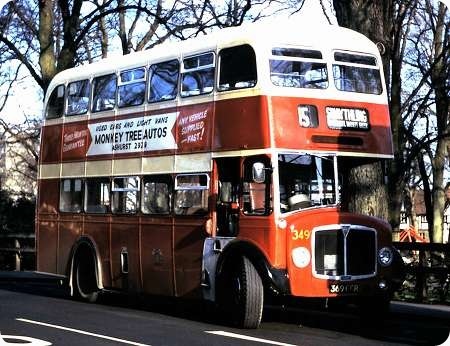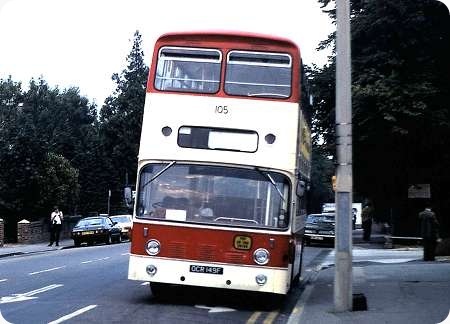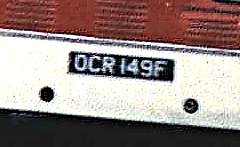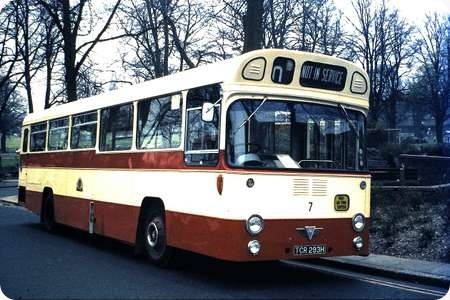
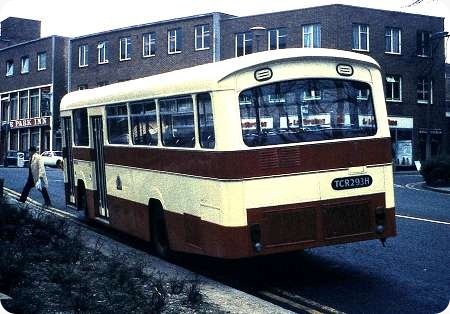
Copyright Pete Davies
Southampton Corporation
1969
AEC 2MP2R Swift
East Lancs B47D
Here are an off side front and a near side rear view of Southampton Corporation TCR 293H fleet number 7. This AEC 2MP2R Swift was built in 1969 with East Lancs B47D bodywork. She is seen in Pound Tree Road between duties. I captured her on film in April 1976. There is something odd about the name of this road, which might be resolved if the UK ever goes fully "European". Does it refer to Kilogram or Euro? After all, there are people who think money grows on trees!
Photograph and Copy contributed by Pete Davies
13/01/13 – 10:27
Please refer to the "Gallery" entry on the King Alfred Running Day for comparative views of the Strachan body on similar chassis.
Pete Davies
13/01/13 – 10:28
Not sure I like ‘peak’ at the front, but otherwise, it’s a nice design in a simple livery. I recall that Seddon bodywork had similar peaks. Sign of the time, I suppose.
I think it’s fair to say that East Lancs bodies were not common along or near the South Coast. They are not too familiar to me as a Southerner.
Maybe the road should be re-named Poundstretcher Road, in recognition of the country’s plight!
Chris Hebbron
13/01/13 – 15:07
No, Chris, EL bodies don’t seem to have had much of a following in the South. I think Eastbourne was the only other Municipal, plus Aldershot & District and Southdown. Southampton bought them because, as one Manager told me, they were "cheap and cheerful"!
Pete Davies
13/01/13 – 15:08
I have a picture of another Southampton Swift/Strachan, MTR 424F, which I hope to submit in a Southampton gallery at some time. As for the rarity of East Lancs bodywork "south of Watford", you’re right, Chris. Aldershot & District and Eastbourne and Luton Corporations had them. To the east, Southend had some, and Lowestoft had a couple of PD2s in 1965. Otherwise, nothing, unless, of course, anyone else knows differently.
It occurs to me that Gideon Osborne would be looking to set up huge plantations of Pound Trees accessed by a thoroughfare called Recovery Road.
Roger Cox
13/01/13 – 17:19
Roger: just the 8 Reliances and 26 Lolines at Reading, of course. Not southern, but geographically south of Watford, there was also also Cardiff with a sizeable number; the Merthyr fleet doesn’t quite qualify as ‘south of Watford’!
The Pound of Pound Tree is surely the place to which illegally parked, or similarly recalcitrant, buses would be towed; in order to suitably screen any double-deckers from public view, it would have been surrounded by trees, the traditional corrugated iron fence being insufficiently tall.
Alan Murray-Rust
13/01/13 – 17:19
East Lancs bodies south of Watford must also include Southdown’s rebodied TD4 and TD5’s carried out between 1946 and 1950 of which there were a total of fifty nine plus of course their final batch of PD2/12’s Nos789-812 considered by many to be the best of the various body builders used on that chassis.
In later years East Lancs became much more popular in the region being bought by Brighton, Portsmouth, Southampton and Plymouth municipalities all outside of the sites timescale I know.
Diesel Dave
14/01/13 – 07:12
I must say, I like Alan’s theory of how the road got its name and Roger’s idea of a plantation of this sort of tree. It may be of interest that the bit of public open space to the nearside of the bus forms a gyratory layout, and is known – among bus crews at least – as WINO ISLAND. Guess why!
Thank you, Dave, for your thoughts on other South Coast operators of the EL (or Neepsend!) bodywork. Almost all of Southampton’s Atlanteans had the product and almost all are too new for these pages. I think the same applies to the Brightons and Portsmouths. The Southampton ones with other bodywork came from Plymouth and were well and truly clapped out when they arrived.
I look forward to Roger’s forthcoming "Southampton Gallery"!
Pete Davies
14/01/13 – 07:13
I can’t imagine how I came to forget the Southdown examples of East Lancs, Dave. I saw them many times when I popped down to Brighton from Croydon. Thanks for reminding me. I agree that the Welsh examples should be included in our survey, Alan. Cardiff is certainly south of Watford, and I doubt that the people of Merthyr would consider themselves to be "northerners" or even "midlanders".
Roger Cox
14/01/13 – 15:34
Southdown also had 40 East Lancs bodied Leyland Royal Tiger PSU1/13 saloons. The first 10 had rear entrances and the rest had centre entrances. All were later converted to front entrance OMO.
Roy Nicholson
16/06/13 – 06:55
To stray from the bus theme but to stay with the ‘Old ‘ bit, a Pound was something every village had back to Norman times, before land was enclosed by greedy landowners. Animals were grazed around the village but strays were rounded up and put in the Pound, released when a fine was paid, The connection with life today is obvious.
Roger Ingle
29/06/14 – 17:27
I cannot add anything to the debate about the name of Pound Tree Road, except to point out that for most of its length the road is between two parks, so there are plenty of trees. If there’s any corrugated iron in the area, it’s on the bus shelters.
As far as East Lancs bodywork is concerned, it might have been cheap – certainly the Venture history of East Lancs reports that their tender for a batch of Mancunians was very competitive. However, it was nevertheless considered to be of good quality, being both substantially built and well finished. The most notable weakness was a tendency to change minor details on every batch of vehicles! I worked for the Transport Department during part of the 1980s, and the engineers were happy with the EL products. SCT did later acquire about a dozen Park Royal/Roe bodied Atlanteans from Plymouth, but as Pete Davies says above, they were past their best, but the interiors were also very utilitarian. Maybe that was down to the operator, but Park Royal seemed to have been on to a cost reduction ‘tick’ since the Leyland PD2s and AEC Regents of the very early 1960s.
I must confess that I quite liked the look of these four Swifts, as the EL single deck styling was subtly different to the contemporary BET design, which had several imitators. Of course. it wasn’t as good as ECW bodied RE, but an interesting contrast. I think the peak at the front, that Chris Hebbron refers to, is a result of the rather high set Swift chassis. A rather neater effect could be achieved on a Bristol RE chassis, with the accompanying benefit of a better mechanical setup!
Nigel Frampton
